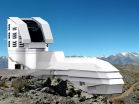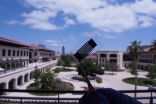(Press-News.org) At a traditional stone-laying ceremony outside La Serena, Chile on April 14th, construction officially began of the Large Synoptic Survey Telescope (LSST). This ambitious international astrophysics project is slated to start scanning the heavens in 2022. When it does, LSST should open up the "dark universe" of dark matter and dark energy--the unseen substance and force, respectively, composing 95 percent of the universe's mass and energy--as never before.
On April 2, 2015, the Director of LSST, Steven Kahn, along with astrophysicist Sarah Bridle and theoretical physicist Hitoshi Murayama, spoke with The Kavli Foundation about how LSST's sweeping search for dark matter and dark energy will answer fundamental questions about our universe's make-up. In the process, LSST will help answer vexing questions about the universe's history and possibly reveal its ultimate fate.
"In terms of how much light it will collect and its field of view, LSST is about ten times bigger than any other survey telescope either planned or existing," said Kahn, the Cassius Lamb Kirk Professor in the Natural Sciences in the Kavli Institute for Particle Astrophysics and Cosmology of Physics (KIPAC) at Stanford University.
LSST will feature an 8.4-meter diameter mirror and a 3.2 gigapixel camera, the biggest digital camera ever built. Every few days, the telescope will survey the entire Southern Hemisphere's sky, hauling in 30 terabytes of data nightly. After just its first month of operations, LSST's camera will have observed more of the universe than all previous astronomical surveys combined.
This capability to rake in data, extended over a ten-year observing run, will yield a staggering amount of astronomical information. The telescope should observe some 20 billion galaxies and many tens of thousands of supernovae. In addition, LSST will help map the stars composing the Milky Way and spy reams of asteroids passing near Earth.
The galaxy and supernova observations, along with other data, will offer some of the most stringent tests of dark matter and dark energy ever conducted. Solving the riddle of dark energy will not only deepen our understanding of our universe's past, but also sketch out its future.
"Dark energy is accelerating the expansion of the universe and ripping it apart," said Murayama, the Director of the Kavli Institute for the Physics and Mathematics of the Universe (Kavli IPMU) at the University of Tokyo and a professor at the Berkeley Center for Theoretical Physics at the University of California, Berkeley. "The questions we are asking are: Where is the universe going? What is its fate? Is it getting completely ripped apart at some point? Does the universe end? Or does it go forever?"
Murayama continued: "To understand these questions, it's like trying to understand how quickly the population of a given country is aging. You can't understand the trend of where the country is going just by looking at a small number of people. You have to do a census of the entire population. In a similar way, you need to really look at a vast amount of galaxies so you can understand the trend of where the universe is going. We are taking a cosmic census with LSST."
To analyze this census, researchers will chiefly rely on a technique called gravitational lensing. Foreground galaxies and their associated dark matter gravitationally bend the light streaming from background galaxies in an observable, measureable way. Gauging this gravitational lensing distortion in LSST's vast image collection will speak to the strength of dark energy, which is accelerating the expansion of the history, at different times in cosmic history.
"With the data, we're going to be able to make a three-dimensional map of the dark matter in the universe using gravitational lensing," said Bridle, a professor of astrophysics in the Extragalactic Astronomy and Cosmology research group of the Jodrell Bank Center for Astrophysics in the School of Physics and Astronomy at The University of Manchester. "Then we're going to use that to tell us about how the 'clumpiness' of the universe is changing with time, which is going to tell us about dark energy."
INFORMATION:
Read the full conversation with Kahn, Bridle and Murayama on The Kavli Foundation website: http://www.kavlifoundation.org/science-spotlights/delving-dark-universe-large-synoptic-survey-telescope
The study, published May 29 in the open access Nature Publishing Group journal Scientific Reports, reveals a direct link between the main culprit of Alzheimer's disease and memory loss.
Alzheimer's disease is characterized by the formation of amyloid plaques in the brain tissue. These amyloid plaques are made up of an insoluble protein, 'Amyloid-beta' (Abeta), which forms small structures called 'oligomers' that are important in the disease progression.
Although these proteins are known to be involved in Alzheimer's, little is understood about how they lead to memory ...
Stanford University scientists have created a new carbon material that significantly boosts the performance of energy-storage technologies. Their results are featured on the cover of the journal ACS Central Science.
"We have developed a 'designer carbon' that is both versatile and controllable," said Zhenan Bao, the senior author of the study and a professor of chemical engineering at Stanford. "Our study shows that this material has exceptional energy-storage capacity, enabling unprecedented performance in lithium-sulfur batteries and supercapacitors."
According to ...
One of the main health targets proposed by the UN Sustainable Development Goals (SDG) is to reduce by one-third premature mortality from non-communicable diseases such as cancer, stroke and dementia. The goals for 2016-2030 define premature mortality as deaths occurring among people aged 69 years old or younger.
The proposed SDG target sends an unambiguous statement to UN member states that health provision for younger groups must be prioritised at the expense of people aged 70 or more, according to the international group of signatories of the letter published in The ...
May 29, 2015 - Researchers are exploring new approaches to designing prosthetic hands capable of providing "sensory feedback." Advances toward developing prostheses with a sense of touch are presented in a special topic article in the June issue of Plastic and Reconstructive Surgery®, the official medical journal of the American Society of Plastic Surgeons (ASPS).
Emerging sensory feedback techniques will provide some sensation and enable more natural, intuitive use of hand prostheses, according to the review by ASPS Member Surgeon Paul S. Cederna, MD, of University ...
May 29, 2015 - As in adults, migraine surgery is effective for selected adolescent patients with severe migraine headaches that don't respond to standard treatments, reports a study in the June issue of Plastic and Reconstructive Surgery®, the official medical journal of the American Society of Plastic Surgeons (ASPS).
ASPS Member Surgeon Bahman Guyuron, MD, Emeritus professor of plastic surgery at Case School of Medicine, Cleveland, and colleagues report good outcomes in an initial experience with migraine surgery in younger patients. They write, "Our data demonstrate ...
May 29, 2015 - People with dementia and other forms of cognitive impairment (CI) have altered responses to pain, with many conditions associated with increased pain sensitivity, concludes a research review in PAIN®, the official publication of the International Association for the Study of Pain. The journal is published by Wolters Kluwer.
The available evidence questions the previous notion that people with CI have reduced pain sensitivity to pain. Rather, "It appears that those with widespread brain atrophy or neural degeneration...all show increased pain responses ...
The 54-question Trauma Symptoms Checklist for Children (TSCC) has been used for decades to test how trauma affects youth in hopes of developing the best treatment and support possible. But interpreting the results can be labor intensive and difficult because the work is done manually and involves a complex matrix from which to draw conclusions.
Now, a Case Western Reserve University social work research team, led by Fredrick Butcher, PhD, a research associate at the Semi J. and Ruth W. Begun Center for Violence Prevention Research and Education, has proposed and tested ...
(WASHINGTON, May 29, 2015) - A new report demonstrates that clinical and genetic factors affecting dose requirements for warfarin vary by race. The study, published online today in Blood, the Journal of the American Society of Hematology (ASH), proposes race-specific equations to help clinicians better calculate warfarin dosage.
Warfarin is the most widely used blood thinning medication, or anticoagulant, prescribed to prevent stroke and to treat blood clots. Determining the optimal warfarin dose to prevent clots while avoiding dangerous bleeding is difficult. To ensure ...
Cosmetics is an important industry worldwide and has attained high levels of sophistication. There are over 10,000 components that can be used to make cosmetics; so it is essential to monitor these components to guarantee consumer safety. Regulation 1223/2009 approved by the European Union in 2009 established a list of components that guarantee consumer safety as well as certain conditions for using these components, such as maximum concentration and what type of products they can be used in.
In his Ph.D. thesis, the researcher Josu López of the Department of Applied ...
Singapore -- Scientists from A*STAR's Bioinformatics Institute (BII) have developed an analytical model and computational tool to rapidly and accurately predict the occurrence and locations of R-loop Forming Sequences (RLFSs) in any genome or artificial nucleic acid sequences. R-loops, which are three-stranded RNA and DNA hybrid structures, can be crucial to many normal biological processes and have also been associated with triggering mutations, DNA breaks and diseases. These hybrid structures provide intriguing possibilities for use as novel targets for diagnostics and ...

